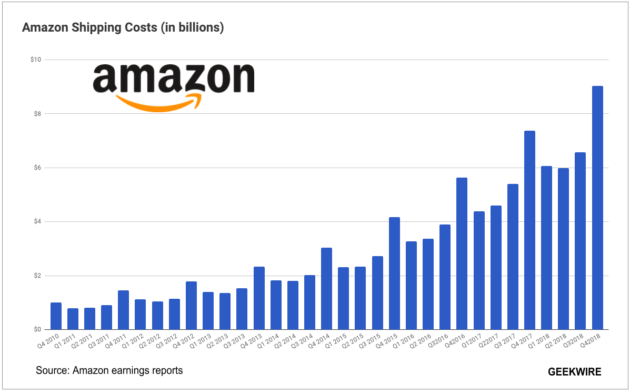While Amazon is known for its speedy shipping, it comes at a cost—a high one. The eCommerce giant continues to raise the bar for delivery speed and its overall service, leaving more shoppers saying, ‘I’ll Just Prime It’ out of convenience, referring to the company’s one to two-day shipping service. And with over 100 million Prime subscribers, Amazon has a lot of shipping to do.
Amazon’s annual shipping costs have risen 140% since 2015. In 2018, Amazon spent almost $28B on shipping, with $9B alone being spent in the last quarter of the year. That is no surprise, given that quarter contains the peak holiday gift season. However, this year’s cost was 23% higher than the year before.
The following chart shows, by quarter, the company’s massive shipping expenditures. It is evident that as Amazon’s delivery windows tighten, their costs rise.

Why So Much?
The growth of Prime, with the benefit of free two-day shipping, means Amazon has been spending a lot more on shipping. With Prime Now in more in 10,000 locations, Amazon says it can serve the majority of its existing Prime members with the newer, faster service. The types of products Amazon is delivering is changing, too. After the acquisition of Whole Foods, Amazon’s food service is available in over 60 cities in the U.S.
Counteracting the Spend
For an online retailer that is known for the speed of delivery, the company cannot easily back down on their fast shipping promises as it has become part of their brand. Instead, Amazon is trying to increase sales volumes and efficiencies within the fulfillment and delivery network to protect their margins. This becomes especially important during the fourth quarter, when Amazon sales spike, and the retailer must often give free service upgrades and split shipments to get packages to customers on time.
In an effort to offset the costs, Amazon increased the cost of its Prime membership from $99 to $119. Amazon CFO Brian Olsavsky stated that rising shipping costs and the digital benefits of the program were the reasons for the higher price. He also pointed out that there are now more than 100 million items available for Prime members, up from 20 million in 2014.
“Shipping with Amazon”
For the retailing giant that seems to dabble in a little of everything, it came as no surprise when the company announced that it would launch its own delivery service to take more control of that expensive last mile of shipping. “Shipping with Amazon” or SWA is a program where Amazon will pick up packages from businesses and deliver them to the consumer.
By delivering directly, Amazon can save money by maintaining more control over schedules, routes, and delivery methods. Amazon is also scaling to meet the ecommerce growth while lessening the risk of relying solely on other carriers whose transportation costs are rising, especially given the driver shortage in the U.S.
To support this expansion, Amazon is investing in equipment and infrastructure. The investments come at a large expense, but one that the company feels is necessary to be able to meet their growing delivery needs. The expansion into other delivery services like grocery helps to diversify and expand the Amazon brand.
